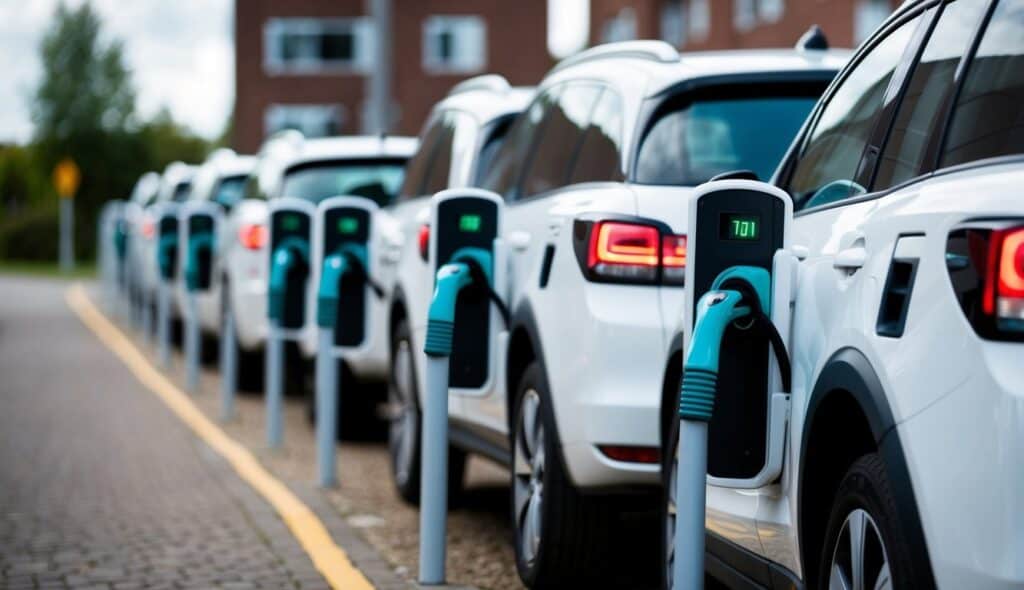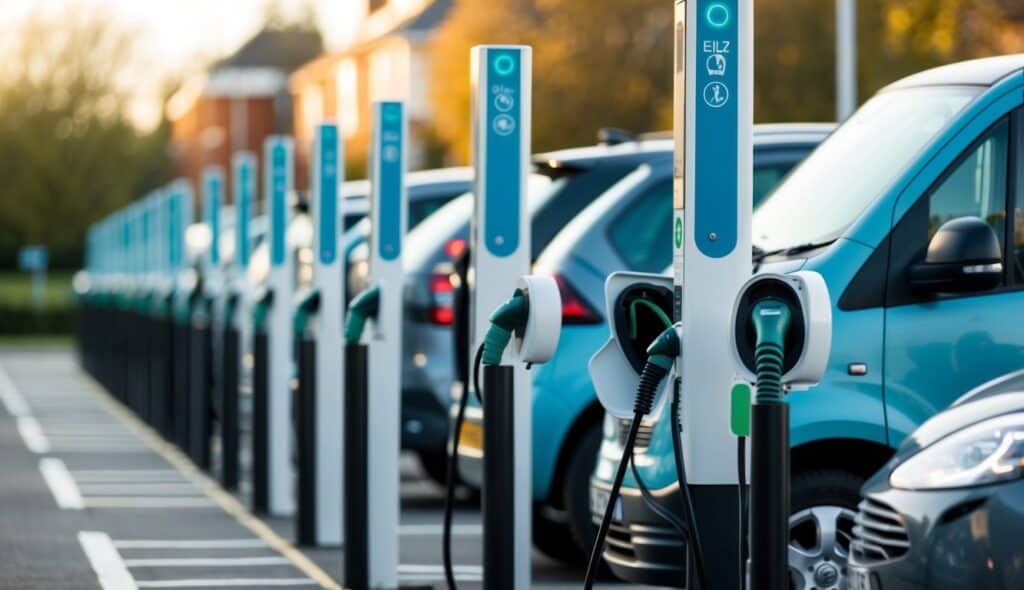Electric vehicle charging points are becoming more common as the world shifts towards sustainable transportation. Many countries now have building regulations that require new constructions to include charging infrastructure. These rules aim to make it easier for people to own and use electric vehicles.
In England, the Building Regulations now include specific requirements for electric vehicle charging points in new buildings and major renovations. This change reflects the growing importance of electric vehicles in reducing carbon emissions and improving air quality. The regulations cover both residential and non-residential buildings, with different rules for each type.
The regulations set out minimum standards for the number and type of charging points that must be installed. They also address technical aspects like power supply and safety features. By including these rules in building codes, governments hope to create a widespread network of charging stations. This will help encourage more people to switch to electric vehicles in the coming years.
Overview of Electric Vehicle Charging Points
Electric vehicle charging points are key to supporting the growing use of electric cars. They provide power to recharge EV batteries and come in different types to meet various charging needs.

The Role of Charging Points in EV Adoption
Charging points are vital for EV owners. They allow drivers to recharge their cars at home, work, or on the go. Easy access to charging helps more people switch to electric vehicles.
Home charging points let EV owners plug in overnight. This gives a full battery each morning. Public charging stations extend driving range for longer trips. Fast chargers can add many miles of range in just 30 minutes.
Workplace charging is also becoming common. It lets employees top up their batteries during the workday. This makes EVs practical for more drivers.
Types of Charging Stations
There are three main types of EV charging stations:
- Level 1 (slow): Uses a standard 120V outlet. Adds about 4-5 miles of range per hour.
- Level 2 (medium): Uses a 240V outlet. Adds about 25 miles of range per hour.
- Level 3 (fast): Uses high-powered DC charging. Can add 100+ miles in 30 minutes.
Level 2 is most common for home and workplace charging. Public stations often offer Level 2 and Level 3 options.
Some chargers work with all EV models. Others are brand-specific. Tesla, for example, has its own charging network.
Building Regulations for EV Charging Points
New rules aim to increase electric vehicle charging infrastructure in England. These regulations set standards for charge point installations in new buildings and major renovations. They also cover adapting existing structures to support EV charging.
Understanding Approved Document S
Approved Document S outlines building regulations for EV charging points in England. It covers requirements for new homes and non-residential buildings. The document sets standards for charge point numbers, power output, and safety features.
Key points include:
- Minimum number of charge points required
- Power output specifications
- Safety and accessibility guidelines
Approved Document S helps builders and developers meet legal requirements. It ensures new buildings are ready for the growing number of electric vehicles.
Requirements for New Buildings
New buildings must include EV charging infrastructure. The rules vary based on building type and size.
For new homes:
- Every new home with a parking space needs a charge point
- Homes with more than 10 spaces need cable routes for future installations
For non-residential buildings:
- One charge point per five parking spaces
- Cable routes for 20% of remaining spaces
These rules apply to new builds and major renovations. They aim to make EV charging widely available and convenient for users.
Adapting Existing Structures
Existing buildings may need updates to meet new EV charging demands. While not required by law, many property owners are adding charge points.
Steps for adapting existing structures:
- Assess current electrical capacity
- Plan charge point locations
- Upgrade electrical systems if needed
- Install charge points and safety features
Older buildings may face challenges like limited electrical capacity. Careful planning can help overcome these issues. Property owners should consult experts to ensure safe and effective installations.
Grants and incentives may be available to help cover costs. These can make it easier for existing buildings to add EV charging options.
Installation Process
Installing electric vehicle charging points involves careful planning, proper infrastructure setup, and thorough testing. These steps ensure a safe and efficient charging system.

Planning and Design
The first step is to assess the site and determine the best locations for charging stations. This includes checking parking layouts, proximity to electrical sources, and accessibility. Designers must consider the number of charging points needed and types of connectors required. They also plan for future expansion.
Building codes and local regulations play a key role in the design phase. Many areas now require new buildings to include EV charging infrastructure. Planners must review these rules to ensure compliance.
The design should account for user convenience and safety. This means placing chargers in well-lit areas with protection from weather when possible.
Electrical Infrastructure Considerations
Proper electrical setup is crucial for EV charging stations. An electrician evaluates the existing power supply to determine if upgrades are needed. This may involve:
- Installing new electrical panels
- Upgrading transformers
- Running conduit and wiring to charging locations
The power requirements depend on the types of chargers being installed. Level 2 chargers need 240-volt circuits, while DC fast chargers require more power and often three-phase electricity.
Electricians must size the wiring and circuit breakers correctly to handle the expected load. They also install safety features like ground fault protection.
Inspection and Testing
After installation, a thorough inspection and testing process is essential. This ensures the charging system meets all safety standards and works correctly. Key steps include:
- Visual inspection of all components
- Testing of electrical connections and grounding
- Verification of proper voltage and amperage at each charge point
- Functional testing with an EV or testing equipment
Local authorities often require official inspections before the system can be used. Inspectors check for compliance with electrical codes and building regulations.
Final testing involves charging actual vehicles to confirm everything works as intended. This helps catch any issues before the system goes live for public use.
Check out Workplace Electric Vehicle Charging Policy UK
Regulatory Compliance
Building regulations play a key role in setting standards for electric vehicle charging points. These rules aim to ensure safety and proper installation.
Compliance with Approved Document S
Approved Document S guides the installation of EV charging points in new buildings. It sets rules for the number and type of charging points required. New homes with parking spaces must have at least one charge point. Larger buildings need more charging spots based on their parking capacity.
The document also covers technical details. It specifies the power output and connector types for chargers. Builders must follow these rules to meet building code requirements.
Safety Standards and Protocols
Safety is a top priority for EV charging installations. Chargers must meet strict electrical safety standards. This includes proper grounding and circuit protection.
Installers need proper training and certification. They must follow specific protocols during setup. Regular inspections help maintain safety over time.
Chargers also need to be weatherproof for outdoor use. They should have features to prevent overheating or electrical faults. Clear labels and instructions are required for safe user operation.
Challenges and Solutions
Building owners face hurdles when adding electric vehicle charging stations. Space limits and power needs are key issues. Smart fixes can help overcome these obstacles.
Dealing with Limited Space
Parking areas often lack room for charging stations. Clever designs can maximize space use. Wall-mounted chargers save floor space. Retractable cables keep paths clear when not in use. Some buildings use stacked parking with chargers. This doubles capacity in tight spots.
Outdoor areas offer more options. Canopies with solar panels can cover chargers. These provide shade and power. For major renovations, planners can add charging zones early. This avoids costly changes later.
Power Supply and Demand Management
EV chargers need lots of power. Old buildings may lack capacity. Upgrades to electrical systems can be costly. Smart charging helps balance loads. It shifts charging to off-peak times. This reduces strain on the grid.
Energy storage systems pair well with chargers. They store power when demand is low. Batteries then supply energy during peak times. This smooths out power use.
Some sites use renewable energy for charging. Solar panels or wind turbines can offset grid power. This cuts costs and carbon footprint.
Technological Innovations
New advancements are making electric vehicle charging faster, more convenient, and easier to use. These technologies aim to improve the charging experience for EV owners.
Wireless Charging Development
Wireless charging pads are being tested for electric vehicles. These allow cars to charge without plugging in a cable. The driver parks over a charging pad in the ground. Power transfers wirelessly to the car’s battery.
Some cities are testing wireless charging in taxi waiting areas. This lets taxis charge while waiting for passengers. A few automakers are also working on dynamic wireless charging. This would let EVs charge while driving on special road sections.
Wireless charging is still new for cars. More testing is needed to make it work well. But it could make EV charging much easier in the future.
Smart Charging Technologies
Smart chargers can communicate with the power grid. They adjust charging based on electricity demand and prices. This helps balance the grid and can save money for EV owners.
Some smart charge points use apps. Drivers can schedule charging for off-peak hours. The chargers can also pause charging if the grid is stressed.
Vehicle-to-grid technology is being developed. It would let EVs send power back to the grid when needed. This could help during power outages or high-demand periods.
Smart charging makes EV charging more efficient. It helps the power grid handle more electric vehicles.

Economic Considerations
Installing electric vehicle charging points involves financial factors for building owners and operators. Costs and potential returns vary based on the type of charger and location.
Cost Analysis of Installing EV Charging Points
The price of EV charging stations ranges from $300 to $50,000 per unit. Level 1 chargers are cheapest but slow. Level 2 chargers cost $2,000 to $5,000 and work well for most needs. DC fast chargers are priciest at $20,000 to $50,000 but charge vehicles quickly.
Installation costs depend on:
- Electrical upgrades needed
- Distance from power source
- Number of charge points
- Labor rates
A basic Level 2 setup may cost $3,000 to $7,000 total. Complex installs with multiple DC fast chargers can exceed $100,000.
Incentives and Financial Support
Many governments offer tax credits, grants, and rebates for EV charging stations. These can offset 20% to 80% of costs.
Common incentives include:
- Federal tax credits up to 30% of costs
- State grants covering $5,000 to $50,000 per charger
- Utility rebates for equipment and installation
Some power companies provide free chargers to businesses. Others offer special EV charging rates.
Building owners may recoup costs through:
- Charging fees
- Increased property value
- Attracting EV-driving tenants and customers
The payback period varies but often ranges from 3 to 7 years.
Frequently Asked Questions
Electric vehicle charging station regulations involve various codes, laws, and guidelines. These cover electrical requirements, accessibility standards, zoning rules, and building codes across different jurisdictions.
What are the NEC code requirements for installing electrical vehicle charging stations?
The National Electrical Code (NEC) sets safety standards for EV charging installations. It requires proper circuit sizing, overcurrent protection, and grounding. The code also mandates specific socket types and markings for EV charging outlets.
How do federal regulations impact EV charging station deployment?
Federal regulations aim to promote EV charging infrastructure growth. They provide funding incentives and set guidelines for interstate charging networks. These rules help standardize charging equipment and ensure interoperability across different regions.
What are the ADA compliance guidelines for electric vehicle charging stations?
ADA guidelines ensure EV charging stations are accessible to all users. They specify requirements for parking space dimensions, charging unit heights, and clear paths. The rules also cover signage and surface conditions to accommodate wheelchair users.
What zoning requirements must be considered when installing EV charging points?
Zoning laws affect where EV charging stations can be placed. They may dictate setbacks from property lines and parking lot layouts. Some zones require permits or limit the number of charging units allowed.
What building codes apply to the installation of EV charging points in California?
California has specific building codes for EV charging installations. These include requirements for the number of EV-ready spaces in new construction. The codes also cover electrical capacity and conduit specifications for future charging expansions.
How does the ‘right to charge’ law affect EV charging station installation in Colorado?
Colorado’s ‘right to charge’ law protects EV owners’ ability to install charging stations. It prevents HOAs and landlords from unreasonably restricting installations. The law sets guidelines for approval processes and cost responsibilities.
Conclusion
Building regulations for electric vehicle charging points are changing fast. New rules aim to make charging easier and more widespread.
Many areas now require new buildings to include EV charging infrastructure. This covers homes, offices, and other structures with parking.
The exact requirements vary by location. Some places mandate a certain number of EV-ready spaces. Others focus on wiring and electrical capacity.
These regulations help prepare for growing EV adoption. They make charging more accessible for EV owners.
Builders and developers need to stay up-to-date on local rules. Planning ahead for EV charging can save time and money.
As technology improves, regulations may continue to evolve. The goal is to support the transition to electric vehicles. This shift impacts how we design and construct buildings.
EV charging infrastructure is becoming a standard part of new construction. It’s an important consideration for future-proofing buildings.
You may also like:

Hi, I’m Marybeth, an electric car enthusiast living in New York in the USA. As the owner of electriccartalks.com, I love sharing my knowledge on EV tips, battery maintenance, and charging solutions. As a proud Tesla owner, I blend my personal experiences with professional insights to offer valuable information to fellow EV enthusiasts. Through my articles, I aim to empower others to make informed decisions about their electric vehicles. Read more